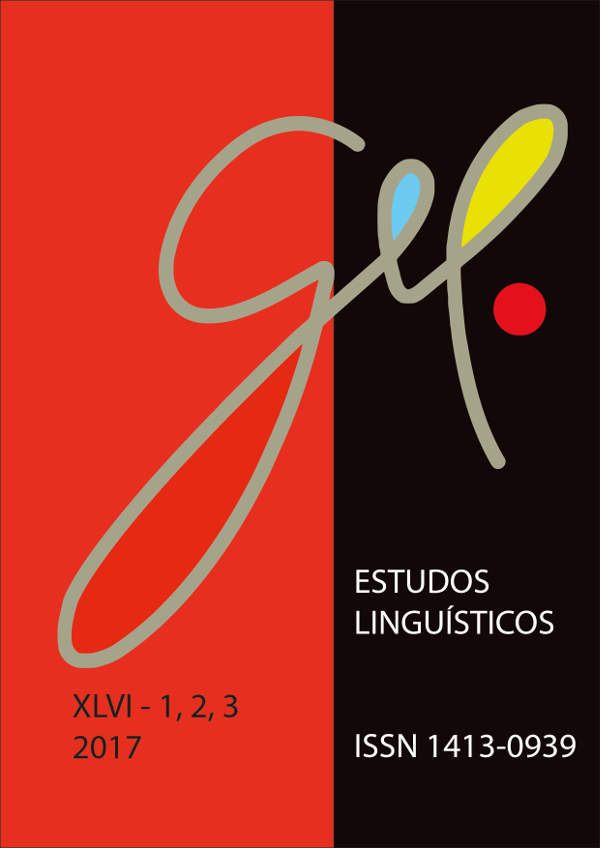Paraphasia, paralexia and their relationship with Word Finding Difficulties
DOI:
https://doi.org/10.21165/el.v46i2.1800Keywords:
paraphasia, paralexia, Word Finding Difficulty (WFD), neurolinguisticsAbstract
This paper results from two researches developed in both Doctorate and Masters Levels in Group of Studies of Language in Aging and Pathologies (GELEP). This paper’s purpose is to discuss the Word Finding Difficulty and the relationship between paraphasia and paralexia. These linguistic-cognitive phenomena provide visibility to the lexical-semantic selection and organization procedures and are frequently associated with aphasia. These phenomena are characterized by the replacement of the intended or target word for another, being so that paralexias occur during the reading process, while paraphasia is the oral exchange of words. Recent researches developed in the context of enunciative-discursive Neurolinguistics (NOVAES-PINTO, 2009, 2014; NOVAES-PINTO; SOUZA-CRUZ, 2013; SOUZA-CRUZ 2014) reveal that lexical-semantic paraphasias are constant in the wording of individuals with fluent aphasia or not and are related to Word Finding Difficulties.Downloads
References
BAKHTIN, M.; VOLOSHINOV, V. Marxismo e Filosofia da Linguagem. São Paulo: Hucitec, 2006.
BOCCATO, D. Paralexia: compreendendo o fenômeno a partir de um estudo de caso no contexto das afasias. Projeto (Mestrado em Linguística) – Instituto de Estudos da Linguagem, Universidade Estadual de Campinas, Campinas, 2016 (Em andamento).
CAZAROTTI-PACHECO, M. Contribuições da análise microgenética às pesquisas em neurolinguística. Revista de Estudos Linguísticos, v. 45, n. 2, p. 582-594, 2016.
COUDRY, M. I. H. Diário de Narciso: discurso e afasia. São Paulo: Editora Martins Fontes, 1988.
DAMICO, J. et al. Qualitative methods in aphasia research: basic issues. Aphasiology,
v. 13, n. 9-11, p. 651-665, 1999.
GÓES, M. C. R. A abordagem microgenética na matriz histórico-cultural: Uma perspectiva para o estudo da constituição da subjetividade. Caderno Cedes, v. 50, p. 9-25, 2000.
JAKOBSON, R. Linguística e Comunicação. São Paulo: Editora Cultrix, 1954.
LURIA, A. R. Pensamento e linguagem: as últimas conferências de Luria. São Paulo: Artes Médicas, 1986.
NOVAES-PINTO, R. C. Indeterminação da linguagem e afasia. Estudos Linguísticos, São Paulo, v. 28, p. 162-167, 1999.
CONGRESSO INTERNACIONAL DA ABRALIN, 6, 2009, João Pessoa. Anais... João Pessoa: UFPB, 2009.
NOVAES-PINTO, R. C.; SOUZA-CRUZ, T. Funcionamento semântico-lexical: discussão crítica com base em dados de situações dialógicas com sujeitos afásicos. Revista de Estudos Linguísticos, v. 41, n. 2, p. 708-722, 2012.
ROJO, R. H. R. Elaborando uma progressão didática de gêneros: aspectos lingüístico-enunciativos envolvidos no agrupamento de gêneros “relatar”. In: Intercâmbio, v. VIII, p. 101-118, 1999.
SOUZA-CRUZ, T. Em briga de marido e mulher ninguém mete... o garfo: Estudo neurolinguístico da produção de parafasias semânticas em sujeitos afásicos. 2013. 100 f. Dissertação (Mestrado em Linguística) – Instituto de Estudos da Linguagem, Universidade Estadual de Campinas, Campinas, 2013.
SOUZA-CRUZ, T. A produção de parafasias em sujeitos com afasias fluentes e não fluentes. Estudos Linguísticos, v. 44, n. 2, p. 853-867, 2015.



